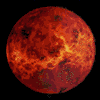 Venus Venus
About the same size as Earth, Venus has a thick, poisonous atmosphere of carbon dioxide and sulfuric acid. The immense heat and pressure at its surface make this planet completely uninhabitable. NASA's spacecraft used a special radar to reveal Venus's surface during four years in orbit from 1990 to 1994. Volcanic lava flows, quake faults and other features on the surface were seen for the first time. The planet was also explored in flybys by , 5 and , and by the orbiting Pioneer Venus spacecraft.
Planet Profile
Mass (kg)............................................4.87 x 10^24
Diameter (km)........................................12104
Mean density (kg/m^3) ...............................5250
Escape velocity (m/sec)..............................10400
Average distance from Sun (AU).......................0.723
Rotation period (length of day in Earth days)........243.0 (retrograde)
Revolution period (length of year in Earth days).....224.7
Obliquity (tilt of axis degrees).....................178
Orbit inclination (degrees)..........................3.39
Orbit eccentricity (deviation from circular).........0.007
Mean surface temperature (K).........................726
Visual geometric (reflectivity)...............0.59
Highest point on surface.............................Maxwell Montes
(17 km above mean planetary radius)
Atmospheric components...............................96% carbon dioxide,
3% nitrogen,
0.003% water vapor
Surface materials.................................... rock and
altered materials
|
 Venus
Venus